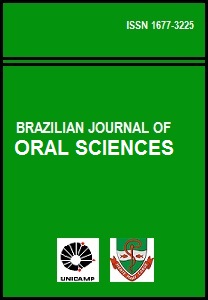Abstract
Quantification and assessment of the evolution of painful symptomology in patients with temporomandibular disorders, during the pre-, trans- and post-therapeutic stages is one of the greatest difficulties found by dental surgeons. Various authors have studied and discussed the use of verbal and non-verbal scales for this purpose. Therefore, this study aimed, by means of a combined experimental scale, to assess the evolution of painful symptomology in patients with completely edentulous maxilla and partly edentulous mandible, with Class I or Class II Kennedy prosthetic spaces, treated with flat occlusal appliances, before, during and after 150 of starting treatment. A selection was made of 16 patients with a mean age of fifty-two years, with signs and symptoms of temporomandibular disorders and diminished vertical occlusion dimension. The patients were submitted to treatment with flat occlusal appliances and fortnightly consultations for a period of 150 days. During these consultations, patients recorded their painful symptomology on a combined experimental pain scale. The results obtained were grouped into tables and submitted to the Friedman Test at a level of 5% probability. These revealed statistically significant differences between the values obtained at each assessment made. According to the methodology used and the results obtained, it was concluded that the therapy used was effective and that the experimental scale was efficient for registering the evolution of the symptoms initially detected.References
Costen JB. Some features of the mandibular articulation as its pertains to medical diagnosis, specially in otolaryngology. J Am Dent Assoc. 1937; 24: 1507-11.
Pretti G, Pera P, Scotti R. Analisi cinematografica della masticazione voluntaria unilateralle. Minerv Stomatol. 1981; 30: 369-73.
Silva FA. Considerações clínicas. In: Silva FA, editor. Pontes parciais fixas e o sistema estomatognático. São Paulo: Santos; 1993. p. 209-27.
Weinberg LA. Role of condylar position in TMJ dysfunctionpain syndrome. J Prosthet Dent. 1979;.41: 636-43.
Pameijer JH. The role of general practitioner in restoring patients with temporomandibular joint dysfunction. Int Dent J. 1988; 38: 40-4.
Laskin, DM, Block, S. Diagnosis and treatment of myofascial pain-dysfunction (MPD) syndrome. J Prosthet Dent. 1986; 56: 75-84.
Silva WAB, Silva FA, Di Hipólito O, Okino LA. Epidemiologic study of the temporomandibular disorders. J Dent Res. 2000; 79(Spec Issue): 584-8.
Feine JS, Lavigne GJ, Thuan Dao TT, Morin C, Lund JP. Memories of chronic pain and perceptions of relief. Pain. 1998; 77: 137-41.
Huskisson EC. Visual analogue scales. In: Melzack R, editor. Pain measurement and assessment. New York: Raven Press; 1983. p. 33-7.
Conti PCR, Azevedo LR, Souza NVW, Ferreira FV. Pain measurement in TMD patients: evaluation of precision and sensitivity of different scales. J Oral Rehabil. 2001; 28: 534-9.
Kuttila M, Le Bell Y, Savolainen-Niemi E, Kuttila S, Alanen P. Efficiency of occlusal appliance therapy in secondary othalgia and temporomandibular disorders. Acta Odontol Scand. 2002; 60: 248-53.
Updegrave WJ. An improved roentgenographic technique for the temporomandibular articulation. J Am Dent Assoc. 1950; 40: 391-401.
Santos Junior J, editor. Oclusão: aspectos clínicos da dor facial São Paulo: Meddens; 1980. p. 145.
Zarb GA, Thompson GW. Assessment of clinical treatment of patients with temporomandibular joint dysfunction. J Prosthet Dent. 1970; 24: 542-54.
Greene CS, Laskin DM. Splint therapy for the myofascial pain-dysfunction (MPD) syndrome: a comparative study. J Am Dent Assoc. 1972; 84: 624-8.
Silva FA, Silva WAB. Reposicionamento mandibular. Contribuição técnica através de férrulas oclusais duplas com puas. Rev Assoc Paul Cir Dent. 1990; 44: 283-6.
Landulpho AB, Silva WA, Silva FA, Vitti M. The effect of the occlusal splints on the treatment of temporomandibular disorders - a computerized electromyographic study of masseter and anterior temporalis muscles. Electromyogr Clin Neurophysiol. 2002; 42: 187-91.
Mongini F. Anatomic and clinical evaluation of the relationship between the temporomandibular joint and occlusion. J Prosthet Dent. 1977; 38: 539-51.
Magnusson T, List T, Helkimo M. Self-assessment of pain and discomfort in patients with temporomandibular disorders: a comparison of five different scales with respect to their precision and sensitivity as well as their capacity to register memory of pain and discomfort. J Oral Rehabil. 1995; 22: 549-56.
Price DD, Bush FM, Long S, Harkins SW. A comparison, of pain measurement characteristics of mechanical visual analogue and simple numerical rating scales. Pain. 1994; 56: 217-26.
Seymour RA, Simpson JM, Charlton JE, Phillips ME. An evaluation of length and end-phrase of visual analogue scale in dental pain. Pain. 1985; 21: 177-85.
Linton SJ, Gotestam KG. A clinical comparison of the pain scales: correlation, remembering chronic pain and a measure of compliance. Pain. 1983; 17: 57-65.
Scott J, Huskisson EC. Graphic representation of pain. Pain. 1976; 2: 175-84.
The Brazilian Journal of Oral Sciences uses the Creative Commons license (CC), thus preserving the integrity of the articles in an open access environment.

